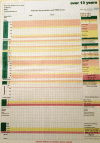Accuracy and Efficiency of Recording Pediatric Early Warning Scores Using an Electronic Physiological Surveillance System Compared With Traditional Paper-Based Documentation
- PMID: 27832032
- PMCID: PMC5708717
- DOI: 10.1097/CIN.0000000000000305
Accuracy and Efficiency of Recording Pediatric Early Warning Scores Using an Electronic Physiological Surveillance System Compared With Traditional Paper-Based Documentation
Abstract
Pediatric Early Warning Scores are advocated to assist health professionals to identify early signs of serious illness or deterioration in hospitalized children. Scores are derived from the weighting applied to recorded vital signs and clinical observations reflecting deviation from a predetermined "norm." Higher aggregate scores trigger an escalation in care aimed at preventing critical deterioration. Process errors made while recording these data, including plotting or calculation errors, have the potential to impede the reliability of the score. To test this hypothesis, we conducted a controlled study of documentation using five clinical vignettes. We measured the accuracy of vital sign recording, score calculation, and time taken to complete documentation using a handheld electronic physiological surveillance system, VitalPAC Pediatric, compared with traditional paper-based charts. We explored the user acceptability of both methods using a Web-based survey. Twenty-three staff participated in the controlled study. The electronic physiological surveillance system improved the accuracy of vital sign recording, 98.5% versus 85.6%, P < .02, Pediatric Early Warning Score calculation, 94.6% versus 55.7%, P < .02, and saved time, 68 versus 98 seconds, compared with paper-based documentation, P < .002. Twenty-nine staff completed the Web-based survey. They perceived that the electronic physiological surveillance system offered safety benefits by reducing human error while providing instant visibility of recorded data to the entire clinical team.
Figures
Similar articles
-
Patterns in the recording of vital signs and early warning scores: compliance with a clinical escalation protocol.BMJ Qual Saf. 2013 Sep;22(9):719-26. doi: 10.1136/bmjqs-2013-001954. Epub 2013 Apr 19. BMJ Qual Saf. 2013. PMID: 23603474
-
Calculating early warning scores--a classroom comparison of pen and paper and hand-held computer methods.Resuscitation. 2006 Aug;70(2):173-8. doi: 10.1016/j.resuscitation.2005.12.002. Epub 2006 Jun 27. Resuscitation. 2006. PMID: 16806641
-
A ward-based time study of paper and electronic documentation for recording vital sign observations.J Am Med Inform Assoc. 2017 Jul 1;24(4):717-721. doi: 10.1093/jamia/ocw186. J Am Med Inform Assoc. 2017. PMID: 28339626 Free PMC article.
-
The value of vital sign trends in predicting and monitoring clinical deterioration: A systematic review.PLoS One. 2019 Jan 15;14(1):e0210875. doi: 10.1371/journal.pone.0210875. eCollection 2019. PLoS One. 2019. PMID: 30645637 Free PMC article.
-
What is the nursing time and workload involved in taking and recording patients' vital signs? A systematic review.J Clin Nurs. 2020 Jul;29(13-14):2053-2068. doi: 10.1111/jocn.15202. Epub 2020 Feb 3. J Clin Nurs. 2020. PMID: 32017272
Cited by
-
Performance of seven different paediatric early warning scores to predict critical care admission in febrile children presenting to the emergency department: a retrospective cohort study.BMJ Open. 2021 May 4;11(5):e044091. doi: 10.1136/bmjopen-2020-044091. BMJ Open. 2021. PMID: 33947731 Free PMC article.
-
Adherence to the bedside paediatric early warning system (BedsidePEWS) in a pediatric tertiary care hospital.BMC Health Serv Res. 2021 Aug 21;21(1):852. doi: 10.1186/s12913-021-06809-2. BMC Health Serv Res. 2021. PMID: 34419038 Free PMC article.
-
Health professionals' initial experiences and perceptions of the acceptability of a whole-hospital, pro-active electronic paediatric early warning system (the DETECT study): a qualitative interview study.BMC Pediatr. 2022 Jun 24;22(1):365. doi: 10.1186/s12887-022-03411-1. BMC Pediatr. 2022. PMID: 35751050 Free PMC article.
-
Introduction of Systematized Nomenclature of Medicine-Clinical Terms Coding Into an Electronic Health Record and Evaluation of its Impact: Qualitative and Quantitative Study.JMIR Med Inform. 2021 Nov 23;9(11):e29532. doi: 10.2196/29532. JMIR Med Inform. 2021. PMID: 34817387 Free PMC article.
-
Assessing the performance of paediatric early warning scores to predict critical deterioration events in hospitalised children (the DETECT study): a retrospective matched case-control study.BMC Pediatr. 2025 Jul 2;25(1):520. doi: 10.1186/s12887-025-05754-x. BMC Pediatr. 2025. PMID: 40604577 Free PMC article.
References
-
- CEMACH. Why Children Die—A Pilot Study 2006. London: CEMACH; 2008.
-
- Department of Health Report of the Children and Young People’s Health Outcomes Forum. London, United Kingdom: Department of Health; 2012.
-
- Randhawa S, Roberts-Turner R, Woronick K, DuVal J. Implementing and sustaining evidence-based nursing practice to reduce pediatric cardiopulmonary arrest. West J Nurs Res. 2011;33(3): 443–456. - PubMed
-
- Thorne S. Interpretive Description. Walnut Creek, CA: Left Coast Press; 2008.
-
- Akre M, Finkelstein M, Erickson M, Liu M, Vanderbilt L, Billman G. Sensitivity of the pediatric early warning score to identify patient deterioration. Pediatrics. 2010;125(4): e763–e769. - PubMed
MeSH terms
LinkOut - more resources
Full Text Sources
Other Literature Sources



